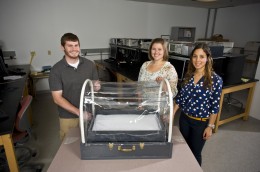
Biomedical engineering students Jessica Hernandez (right), Joanna Newton and Jacob Durdel display the incubator they designed and built. The incubator and others will be sent to the Congo in Africa.
By any measure it’s low-tech–with its plastic base and supports, a vinyl tent-like cover and a couple of heating elements. But it’s designed to be just that. And it promises to be life-saving.
The incubator is the senior design project of three Wright State University undergraduate biomedical engineering students. In June, four of the incubators will be transported to the Democratic Republic of the Congo, where they are desperately needed for premature and ill babies.
“We’re actually doing a project that’s going to save lives,” said student Jessica Hernandez of Centerville, Ohio.
The students became interested in designing and building an incubator after Dr. Sylvia Esser-Gleason, coordinator of Project Congo, talked to one of their classes and suggested it. Project Congo is a charity Esser-Gleason, a Wright State graduate, created to raise money for life-saving medical equipment and supplies for the Congo.
The Congo has been devastated by civil war and armed conflicts. Since 1994, more than 6 million people in the central African nation of 71 million have died due to warfare, disease and starvation.
Student Joanna Newton of North Jackson, Ohio, said low-weight births are a common and often fatal problem in developing countries, with one in three infants in the Congo born prematurely or severely underweight. Such infants have trouble regulating their body temperatures and are highly susceptible to infection.
The students’ incubators will be sent to the Don Bosco Ngangi Medical Center and the Project Congo hospital in Goma, an area of the Congo ravaged by fighting and filled with refugees.
Esser-Gleason said conventional incubators sent to the Congo from Europe rapidly fall into disuse because of simple problems such as blown fuses. She said a study has shown that 95 percent of all medical equipment sent to Africa ends up non-functional within five years.
“And the high-tech incubators often have features which will not be used, such as cardiac monitoring and oxygen administration,” she said.
Student Jacob Durdel of Fremont, Ohio, said the hospital only has power for 12 hours a day.
“Our main goal was to build an incubator that will regulate temperature, run on battery power for up to 24 hours, is easy to clean, and can be produced locally by Goma craftsmen,” said Newton.
Durdel said the incubator has two heaters—225 watt and 100 watt—capable of producing heat of up to the necessary 96 degrees. A thermostat and temperature probe maintains steady heat. In addition, there is a battery, an inverter and a charger so that the incubator has 24-hour-a-day power.
The incubator is also made with PVC and other materials and components that are accessible and can be easily sanitized, a critical feature with the prevalence of diseases and illnesses in Third World countries.
The incubator is easily disassembled and folds up into a suitcase-like box. The 45-pound package can be handily carried, transported and reassembled, making it ideal for use at other Congo hospitals and refugee camps.
The incubator is also relatively inexpensive to make, costing less than $500. The students intend for workers and suppliers in Goma to begin producing additional incubators, which were also designed with materials that are easy to repair.
“I feel the Wright State design is easier to build with local resources, easier to maintain and troubleshoot, and can run on minimal energy requirements,” said Esser-Gleason. “The plastic tent design is easy to clean and easy to construct with a pedal-type sewing machine and could provide local opportunities for women.”
Hernandez hopes to see the incubator project spread throughout Africa and Third World countries.
“It can make a big difference for countries that really don’t have the means to have expensive incubators,” she said.
The incubator has gotten the students some national attention.
They and their incubator were selected to take part in the National Undergraduate Global Health Technologies Design Competition last March at Rice University in Houston, competing against 23 university teams from schools such as Johns Hopkins, Vanderbilt and Michigan.
“The project truly has the potential to save infant lives,” said Esser-Gleason.

 Wright State University Foundation awards 11 Students First Fund projects
Wright State University Foundation awards 11 Students First Fund projects  Gov. DeWine reappoints Board Treasurer Beth Ferris and names student Ella Vaught to Wright State Board of Trustees
Gov. DeWine reappoints Board Treasurer Beth Ferris and names student Ella Vaught to Wright State Board of Trustees  Joe Gruenberg’s 40-Year support for Wright State celebrated with Honorary Alumnus Award
Joe Gruenberg’s 40-Year support for Wright State celebrated with Honorary Alumnus Award  Wright State’s elementary education program earns A+ rating for math teacher training
Wright State’s elementary education program earns A+ rating for math teacher training  Wright State’s Calamityville hosts its largest joint medical training operation
Wright State’s Calamityville hosts its largest joint medical training operation 